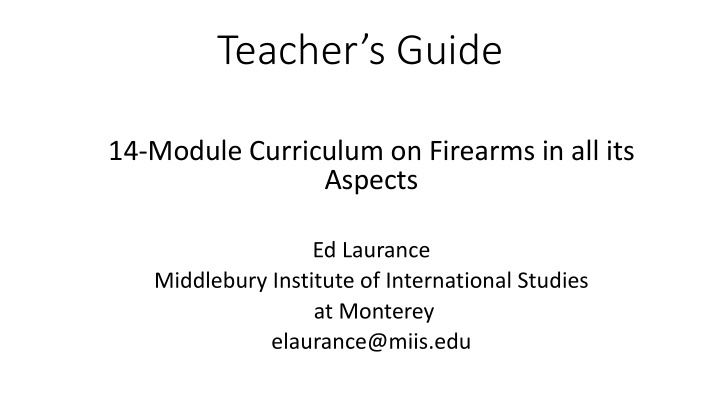



Teacher’s Guide 14-Module Curriculum on Firearms in all its Aspects Ed Laurance Middlebury Institute of International Studies at Monterey elaurance@miis.edu
Goals of the Project • Not just education- sustainable change • Promote evidence-based research • Networking • Multidisciplinary- not just the Firearms Protocol • Disciplines: Law, criminology, political science, international relations, peace and security studies • Global audience • Grad and undergrad
More Goals • Formal and informal • University level • Higher vocational training • Variety of methods beyond lectures- simulations, etc. • Develop incentives for universities to teach these modules on firearms • Develop epistemic community
Teachers Guide Outline • Global situation of increasing firearms crime and violence The objective of this section is to highlight the critical nature of the firearms problem, one that increasingly affects most countries of the world. It needs to be graphic with a sense of urgency. Growing need for increased education on illicit firearms and their impact that leads to more effective policies and programs resulting in sustainable change in the form of reduced violence and crime with firearms. This section provides the reasons why tertiary level teachers should embrace this curriculum. It provides the incentives for doing so and why students would embrace this curriculum. We know there is almost no such education in place at the tertiary level. [Or is there?]
Teachers Guide Outline II • The curriculum should lead to sustainable change, that is, the prevention and reduction of the negative effects of the illicit trafficking, diffusion, manufacture and criminal use of firearms. • Each module contains enough information and variety of methods and tools that it can be applied by the at the undergraduate and graduate levels of study, as well as online, more informally (e.g., for NGOs) and for short workshops for professionals engaged in work in the area of firearms. • The most effective approach to achieving the objectives of this curriculum on firearms and all its aspects is to develop modules that can be adapted for use in the local, national or regional context closest to the concerns and interests of the students.
Academic Disciplines • The curriculum is designed to be used in a variety of academic disciplines, in a variety of packages- mix and match • Law • Criminology • Political Science • International Relations • Peace and Security Studies • Public Health • Public Policy • International Development • Economics
The Modules Format 1. Introduction . One paragraph describing the module's key objectives. 2. Learning Outcomes A maximum of five learning outcomes in bullet point form. 3. Module Overview Narrative overview of key issues to be covered when teaching the module in question. 4. Exercises Include case studies and other in-class or pre-class exercise 5. Recommended Class Structure 6. Core Readings List of open access required readings to understand the module in question. 7. Advanced Readings A list of readings (as many as possible should be open access), which the lecturer could assign to advanced students, organized by academic discipline if relevant. 8. Student Assessment 9. Additional Teaching Tools • PowerPoint presentations, handouts, case studies, ideas for assignments, quizzes and other resources that could help lecturers teach the module in question.
Modules 1-5 Module 1. The consequences of the illicit acquisition, manufacture, diffusion trafficking, and misuse use of firearms/SALW Social, economic and humanitarian consequences and directly impact development, human security and safety. Exacerbate conflict, gun crime, enhance terrorism and organized crime Module 2 . Firearms and ammunition (Firearms 101) Module 3. Legal Firearms/SALW Transfers Module 4. Illicit trafficking of firearms/SALW Module 5. Legal Frameworks and Instruments to Reduce and Prevent Illicit Firearms Trafficking
Modules 6-11 • Module 6. Firearms/SALW, Terrorism and International Organized Crime • Module 7. Firearms, Crime and Criminal Justice Systems • Module 8. Firearms and Development- SDG 16 • Module 9. Firearms and the public health approach to the prevention and reduction of firearms violence. • Module 10. Planning and conducting evidence-based research on firearms • Module 11. Use of firearms by police and other law enforcement officials
Modules 12-15 • Module 12. Intelligence and data collection This module reviews the various sources of data on firearms needed to effectively conduct policy and program work to prevent and reduce firearms crime and violence. It would be a prerequisite module for Modules 7, 10 and 13. • Module 13. Design, monitoring and evaluation of programs that seek to lower the negative effects of the illicit acquisition, trafficking, diffusion, manufacturing and criminal use of firearms. • Module 14 . Border Controls • Module 15 . Illicit manufacturing
Request Your Help in Building These Modules Thank You! Ed Laurance Middlebury Institute of International Studies elaurance@miis.edu
Recommend
More recommend